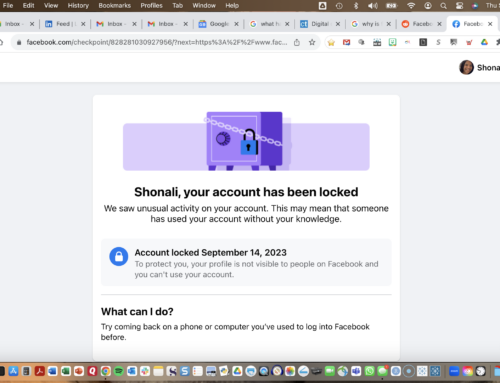 Disclosure: Heidi Sullivan, who is featured in this post, works for Cision, which is an SBC client. However, Heidi is also a very good friend, and our friendship long pre-dates SBC’s and Cision’s business relationship. So there.
Disclosure: Heidi Sullivan, who is featured in this post, works for Cision, which is an SBC client. However, Heidi is also a very good friend, and our friendship long pre-dates SBC’s and Cision’s business relationship. So there.
AVEs rear their ugly head
The other day, a friend of mine pinged me into a Facebook conversation about whether or not PR pros should use AVEs when measuring their work. Now, I’ve ranted so much about AVEs, I feel I’ve said all I have to say about it… but of course, I couldn’t resist.
So I expounded a bit – just a bit, mind you – and as the conversation proceeded, I had cause to scroll up and down the comments. And one that left me absolutely gobsmacked was when someone said it put a monetary value on our work, that is often greater than what we get paid.
Shut. The. Door.
Not only is this ridiculous, it does not put a monetary value on our “work” (what work? The elbow grease? The “hits”? Other, actual outcomes?). Also, it reeks to me of “smoke and mirrors.” Are we that under-confident as an industry that we have to resort to fecal metrics (yes, I said it) to justify our fees?
If you are using AVEs, I understand that sometimes, you have to, to keep clients happy. However, when given a choice we absolutely should not and, even if we have to, we should be trying to educate our clients on better and more effective metrics. Now that is what will result in them paying our fees happily… if that is the issue at hand!
We do have a lot of confusion in the measurement space, and with the lines blurring between social, marketing, PR, you name it, there is constantly pressure to show how you’re engendering “success.” So I do get it.
Introducing Digital Reach
And apparently my client Cision gets it as well, with the introduction of their new metric, Digital Reach, that factors social sharing into the value of an outlet’s website (or sub-site). In a nutshell, here is what DR is:
Typically, sites report on “unique visitors per month” (UVPM). But we can’t always get exact numbers, e.g. for third-party sites, so in those cases UVPM has been determined by using a small sample. Digital Reach, however, tracks links shared across the web, which captures a global sense of viewers, instead of a small sample of users.
So it reflects the way users are actually viewing and sharing content across the web, including via social media.
For social media, DR looks at a sample of sites, and examines the relationship between each site’s UVPM and corresponding social media share counts. From that sample, a statistical model is developed that mathematically expresses the relationship between a site’s UVPM and its social media share counts.
I’m still exploring it myself, but I can tell you that it’s a heck of a lot better than AVE. And maybe it will get all of us thinking about more valid metrics, as well as getting us PR pros to march to a newer, fresher, drumbeat.
Image: James Jordan via Flickr, CC
Have a listen to the interview Cision’s Heidi Sullivan (note above disclosure) did with Martin Waxman of Inside PR. Heidi goes into DR in great detail, and the thoughtful discussion that follows – from Martin, Gini Dietrich, and Joe Thornley – is equally valuable.
Coming up: @hksully on #measurePR
I’m thrilled that Heidi will be a guest on this month’s #measurePR Twitter chat (yes, it’s August already!). We’ll be talking social media metric nerdery (that’s a word, right?), why and how PR needs to stop being a cost-center and, of course, AVEs and Digital Reach.
So follow Heidi (@hksully) if you don’t already, me too (please!), and join us next week: August 6 5, 12-1 pm ET. We’ll be on Twitter, and as usual, all you have to do is join the fun using the #measurePR hashtag.
See you there, I hope, and have a great weekend!



![[EVENT]: PR Hacks for Small Biz (online)](https://shonaliburke.com/wp-content/uploads/2021/06/FB-Ad-1200x800-01-01-01-Copy-500x383.jpeg)





Shonali Thank you for suggesting it! ggSolutions123 martinwaxman hksully ginidietrich thornley
ggSolutions123 Thanks so much for joining! Yes, I thought the interview that martinwaxman did with hksully was terrific… and I really enjoyed the commentary ginidietrich and thornley had as well.
Hope to see you at #measurePR next month!
Thanks for the great Twitter chat today. I found this audio file about Cision Digital Reach in case you haven’t heard it yet. But I think you probably did. http://hwcdn.libsyn.com/p/7/9/4/794c08a66c73f59d/fir-ipr-380.mp3?c_id=7455152&expiration=1407318355&hwt=bd6aaedde9a8af503068addcd2692c55
Fecal metrics AND Shut. The. Door. both made me laugh out loud. I wonder if the person who said this just doesn’t know any better? Perhaps this person’s boss(es) asks for those kinds of metrics? Whatever the case, we HAVE to do better. There is so much out there on this big world wide web that talks about measuring our efforts to real results. Heck, they could just read this blog and think about things differently.
That said, until PRSA stops rewarding AVEs and media impressions as results in their awards programs, there is no real reason to change.